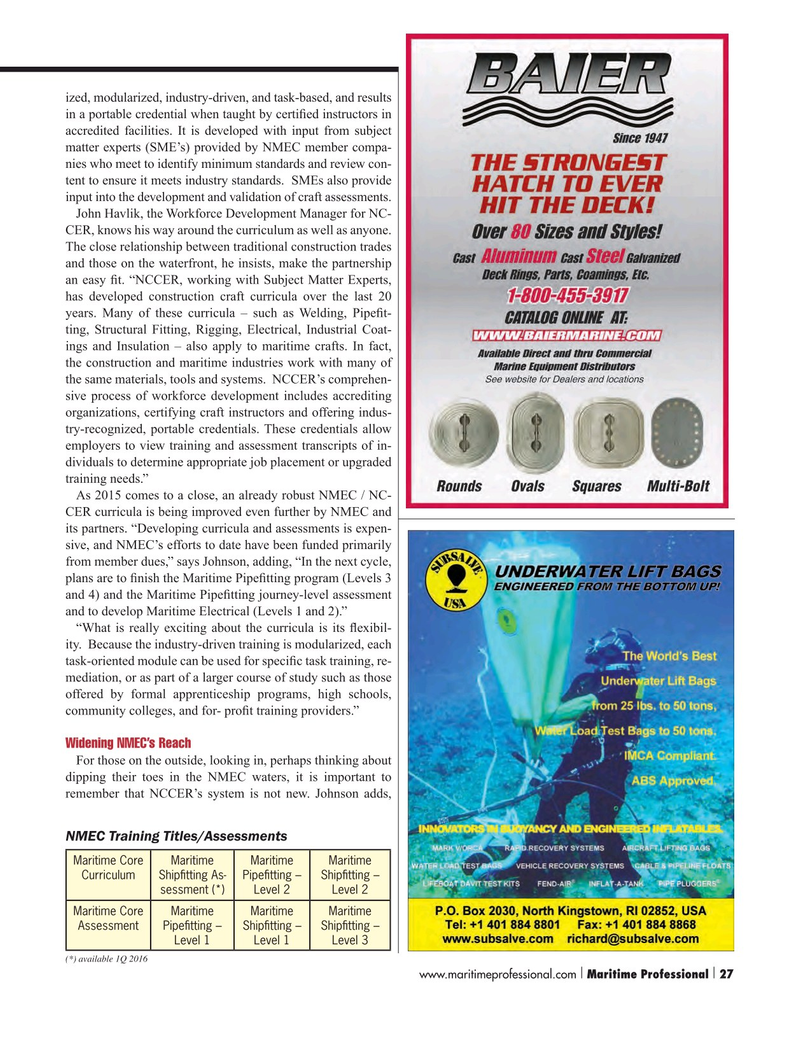
Page 27: of Maritime Logistics Professional Magazine (Q4 2015)
Read this page in Pdf, Flash or Html5 edition of Q4 2015 Maritime Logistics Professional Magazine
ized, modularized, industry-driven, and task-based, and results in a portable credential when taught by certi? ed instructors in accredited facilities. It is developed with input from subject matter experts (SME’s) provided by NMEC member compa- nies who meet to identify minimum standards and review con- tent to ensure it meets industry standards. SMEs also provide input into the development and validation of craft assessments.
John Havlik, the Workforce Development Manager for NC-
CER, knows his way around the curriculum as well as anyone.
The close relationship between traditional construction trades and those on the waterfront, he insists, make the partnership an easy ? t. “NCCER, working with Subject Matter Experts, has developed construction craft curricula over the last 20 years. Many of these curricula – such as Welding, Pipe? t- ting, Structural Fitting, Rigging, Electrical, Industrial Coat- ings and Insulation – also apply to maritime crafts. In fact, the construction and maritime industries work with many of the same materials, tools and systems. NCCER’s comprehen- sive process of workforce development includes accrediting organizations, certifying craft instructors and offering indus- try-recognized, portable credentials. These credentials allow employers to view training and assessment transcripts of in- dividuals to determine appropriate job placement or upgraded training needs.”
As 2015 comes to a close, an already robust NMEC / NC-
CER curricula is being improved even further by NMEC and its partners. “Developing curricula and assessments is expen- sive, and NMEC’s efforts to date have been funded primarily from member dues,” says Johnson, adding, “In the next cycle, plans are to ? nish the Maritime Pipe? tting program (Levels 3 and 4) and the Maritime Pipe? tting journey-level assessment and to develop Maritime Electrical (Levels 1 and 2).” “What is really exciting about the curricula is its ? exibil- ity. Because the industry-driven training is modularized, each task-oriented module can be used for speci? c task training, re- mediation, or as part of a larger course of study such as those offered by formal apprenticeship programs, high schools, community colleges, and for- pro? t training providers.”
Widening NMEC’s Reach
For those on the outside, looking in, perhaps thinking about dipping their toes in the NMEC waters, it is important to remember that NCCER’s system is not new. Johnson adds,
NMEC Training Titles/Assessments
Maritime Core Maritime Maritime Maritime
Curriculum Ship? tting As- Pipe? tting – Ship? tting – sessment (*) Level 2 Level 2
Maritime Core Maritime Maritime Maritime
Assessment Pipe? tting – Ship? tting – Ship? tting –
Level 1 Level 1 Level 3 (*) available 1Q 2016 www.maritimeprofessional.com Maritime Professional 27 | | 18-33 Q4 MP2015.indd 27 11/18/2015 10:10:13 AM

 26
26

 28
28
